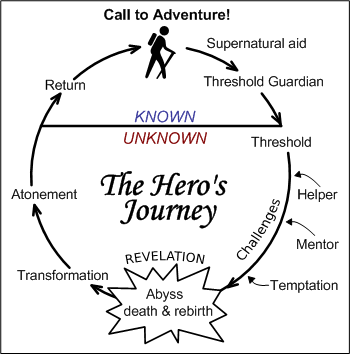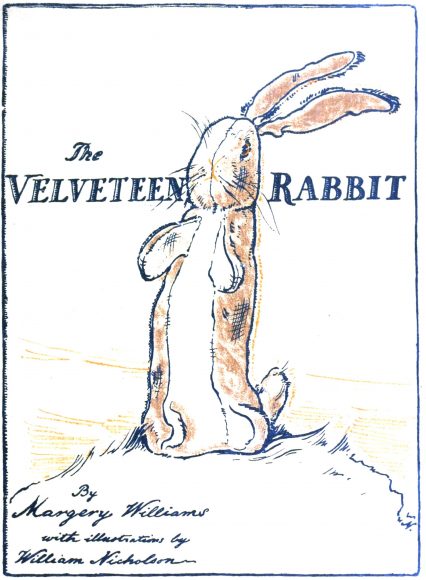
This blog entry is a bit of a deviation from my plan because in the last entry on the writing process, I discussed the act of “emerging” characters and felt that I needed to go deeper into my thoughts on this important process. So we’ll start with how Hollywood (and many others) think about emerging their leading characters.
The Hero’s Journey
The Hero’s Journey is a well-worn strategy to developing a character’s emergence throughout the narrative of a story or (especially) a movie. It has been well-described by mythologist Joseph Campbell in his book The Hero with a Thousand Faces, and time has made it very clear that it can be a very convenient pattern for many authors and screenwriters because it is attractive to consumers and inspirational. And… it is easy to disguise so people don’t get sick of it. See the graphic below. Perhaps some lives follow this cycle of growth, but my thought is that perhaps not so many as we would imagine. We know the life of Luke Skywalker and Harry Potter follow this exact journey, because George Lucas admitted as such and in places it appears that JK Rowling used it as a template. But do normal characters’ lives follow this approach, and if not, is strict adherence to the Hero’s Journey going to make your characters “exciting but not real”?

Making Characters Real AND Interesting?
Here are a few of my concerns with over-reliance on the Hero’s Journey in literature.
- The Journey vs. the Character. Many times the reader can be distracted (intentionally?) into believing that the manner in which the character undertakes the journey and the problems the character attacks to finally be able to “return” are more important than the characters’ “becoming real”. I think this is a true challenge in our current era where we value authenticity publicly with our lips, but then destroy it privately with our actions. I probably don’t have to give many people examples of this to gain consensus. Perhaps this is one of the largest disappointments of our last ten years or so of political polarization, the death of the authentic individual.
- Cultural Homogeneity. I’m not convinced that the Hero’s Journey maps well across cultures. I sometimes wonder if patterns like this are quietly destroying non-conforming cultures.
- The Dark Hero’s Journey. By its nature, the Hero’s Journey leans towards a selfish exercise followed by the main character, with supporting characters scattered around to further their journey. This isn’t always bad and can be a tool to reveal something interesting in a character, but sometimes the Hero’s self-centeredness can devastate all around them in real life rather than provide salvation. This is a counter-pattern that probably doesn’t sell well when applied to books and movies, but unfolds around us all the time. Rewrite the stories of the people who have created the most destruction with their lives using the Hero’s Journey pattern and you’ll find that they often fit, but the outcomes are far from heroic (I’ll leave that as an exercise for the reader). Perhaps this may challenge our sense of morals and virtues (and it’s weaker cousin “values”), but that is a good thing to be thinking about when trying to help your character “emerge” in your story.
- Emergence of REAL Characters. Fitting characters (and supporting characters) into a pattern reduces them to just a token that the author hopes to use to satisfy their OWN goals. If an author seeks to understand and introduce readers to a character that they would love to know better themselves, they are not likely to want to present a two-dimensional pattern. However, if they seek to sell a few books and maybe even get a movie deal, maybe the pattern is the fastest way. But I’d submit in most cases it’s not lasting.
An Example of REAL Character Emergence

In The Velveteen Rabbit, we see Margery Williams emerging her characters, toys that have a desire to become REAL in loving and careful ways. What she does not do is hide the growth process under that gloss of the Hero’s Journey. She shows the struggles and disillusionment and the sadness than co-exist with a character’s true journey, as opposed to their idealistic journey. Getting to REAL in The Velveteen Rabbit is costly. So it is in the real world too. Hank Williams put it well in his frequently-covered song, “No matter how I struggle and strive / I’ll never get out of this world alive”
From The Velveteen Rabbit
“Real isn’t how you are made,” said the Skin Horse. “It’s a thing that happens to you. When a child loves you for a long, long time, not just to play with, but REALLY loves you, then you become Real.”
“Does it hurt?” asked the Rabbit.
“Sometimes,” said the Skin Horse, for he was always truthful. “When you are Real you don’t mind being hurt.”
“Does it happen all at once, like being wound up,” he asked, “or bit by bit?”
“It doesn’t happen all at once,” said the Skin Horse. “You become. It takes a long time. That’s why it doesn’t happen often to people who break easily, or have sharp edges, or who have to be carefully kept. Generally, by the time you are Real, most of your hair has been loved off, and your eyes drop out and you get loose in the joints and very shabby. But these things don’t matter at all, because once you are Real you can’t be ugly, except to people who don’t understand.” – Margery Williams’ “The Velveteen Rabbit”
LINKS TO THE SERIES:
- Introduction
- Project inspiration and organization
- Research, note-taking
- Setting up a Project for Success
- The writing process (building discipline, maintaining enthusiasm, unfolding plot-lines and emerging characters)
- Thoughts on the Character’s Journey
- Self-Publishing: Typesetting and Tools
- Self-Publishing: The Art of Editing

